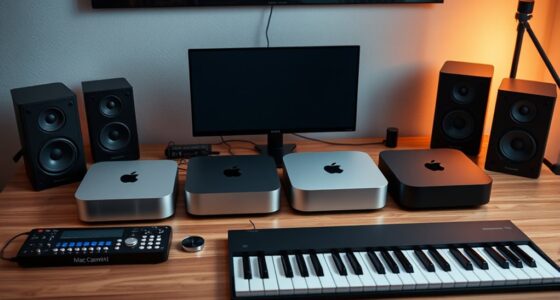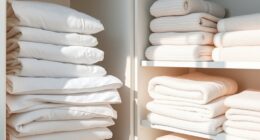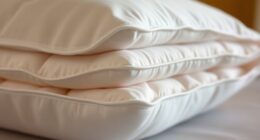To keep your floors looking their best, it’s essential to know each type’s specific needs. Use gentle tools like microfiber mops, vacuum with soft attachments, and manufacturer-approved cleaners. For hardwood, clean with damp microfiber cloths and wipe spills immediately, while tiles benefit from grout sealing. Vinyl and laminate floors need gentle soap solutions, and carpets should be deep cleaned regularly. Implement protective measures like furniture pads and doormats, and for stubborn issues, consider professional help—more insights await you.
Key Takeaways
- Different flooring types require specific cleaning methods and products to prevent damage and maintain appearance.
- Regular sweeping, vacuuming, and immediate spill cleanup are essential for floor longevity across all materials.
- Use manufacturer-approved, pH-neutral cleaners and appropriate tools like microfiber mops for safe, effective cleaning.
- Protective measures such as furniture pads, doormats, and proper maintenance extend floor lifespan and prevent scratches.
- Schedule professional deep cleaning and repairs periodically to preserve and restore various floor surfaces.
Understanding the Characteristics of Various Flooring Materials
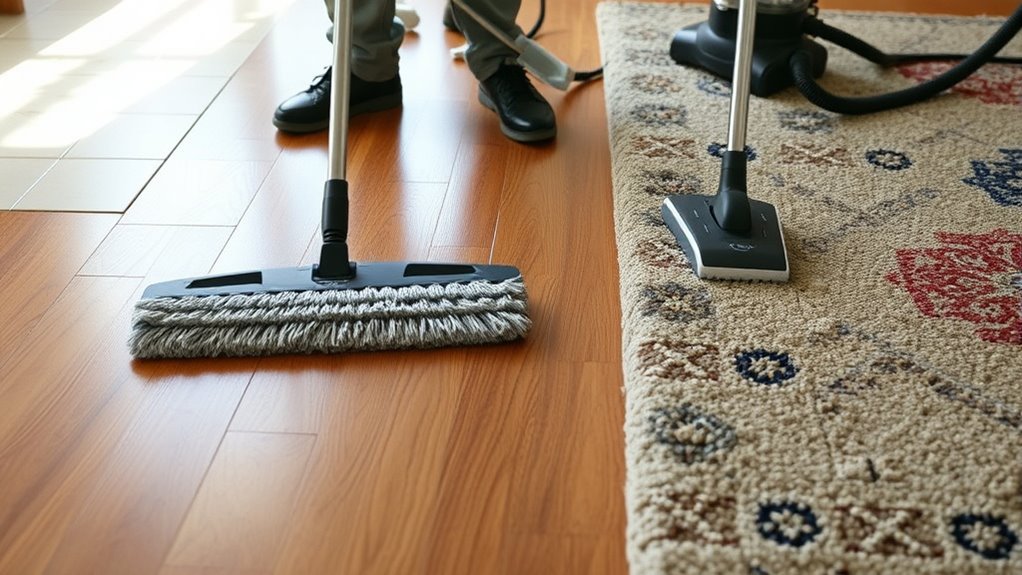
To choose the right cleaning methods, you first need to understand the unique characteristics of each flooring material. Hardwood floors are durable and long-lasting but are sensitive to moisture, which can cause warping or cupping. Engineered hardwood offers better stability and resistance to humidity, making it suitable for various environments. Laminate flooring mimics wood with a high-density fiberboard core and resists fading, but it’s vulnerable to water damage and stains if exposed to excess moisture. Vinyl flooring, including luxury vinyl tiles and planks, is highly water-resistant and soft underfoot, making cleaning easier and protecting against damage. Tile floors, such as ceramic or porcelain, vary in porosity and durability, impacting how you should clean them and their resistance to stains or damage. Each material demands specific care to maintain its appearance and longevity. Understanding the water resistance of different flooring types can help prevent damage caused by improper cleaning techniques. Additionally, knowing the moisture sensitivity of hardwood can guide you in avoiding excess water during cleaning, thereby prolonging its lifespan. Recognizing the advances in flooring technology can also inform you about new materials and coatings that improve durability and ease of maintenance. Furthermore, familiarizing yourself with the cleaning requirements of each type can help you select appropriate cleaning products and methods. Being aware of proper cleaning techniques ensures that you do not inadvertently damage delicate surfaces or coatings, extending the life of your flooring.
Essential Tools and Supplies for Effective Floor Cleaning
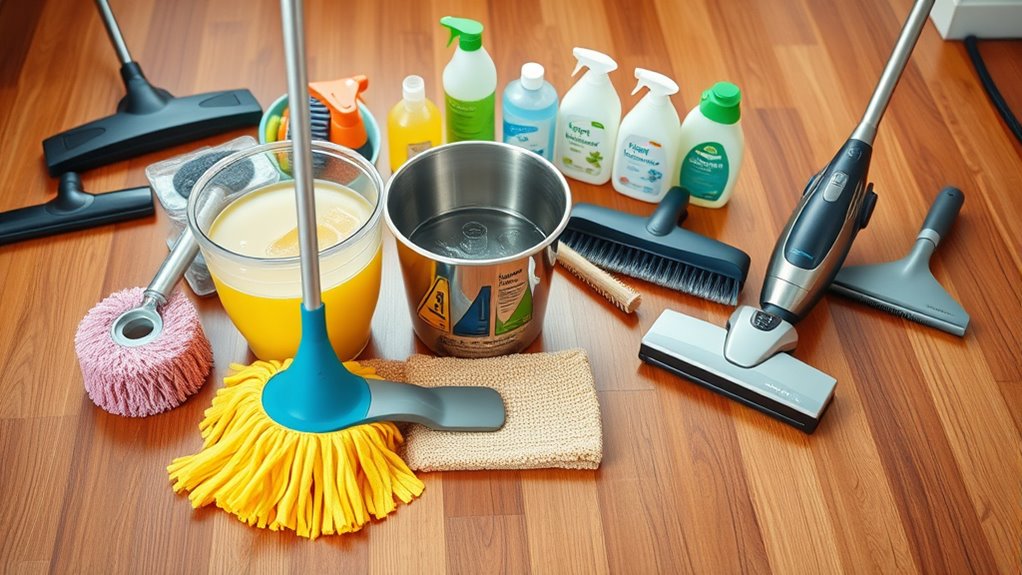
Choosing the right cleaning tools makes a significant difference in maintaining various flooring types. A microfiber mop is excellent for lint-free, gentle cleaning on hardwood, laminate, and vinyl floors. A vacuum cleaner with adjustable settings and soft bristle attachments safely removes debris from carpets and tiled surfaces without damage. Always use manufacturer-approved cleaners, such as pH-neutral solutions, to protect your floors’ finish. Keep a variety of scrubbing tools, including soft and stiff bristle brushes, to tackle grout or textured surfaces without scratching. Incorporating professional cleaning techniques can help you achieve better results and extend your floors’ lifespan. Using the appropriate cleaning techniques for different floor types helps prolong their lifespan and appearance. Regularly scheduled cleaning routines and specialized cleaning products tailored for each floor material further enhance longevity and appearance. Incorporating vacuum performance metrics such as suction power and filtration systems can improve cleaning efficiency and protect delicate flooring surfaces. Additionally, understanding the importance of floor maintenance routines can aid in preventing damage and maintaining a pristine look. These essential supplies help guarantee your floors stay clean and well-maintained while minimizing potential damage.
Best Practices for Daily and Weekly Floor Maintenance
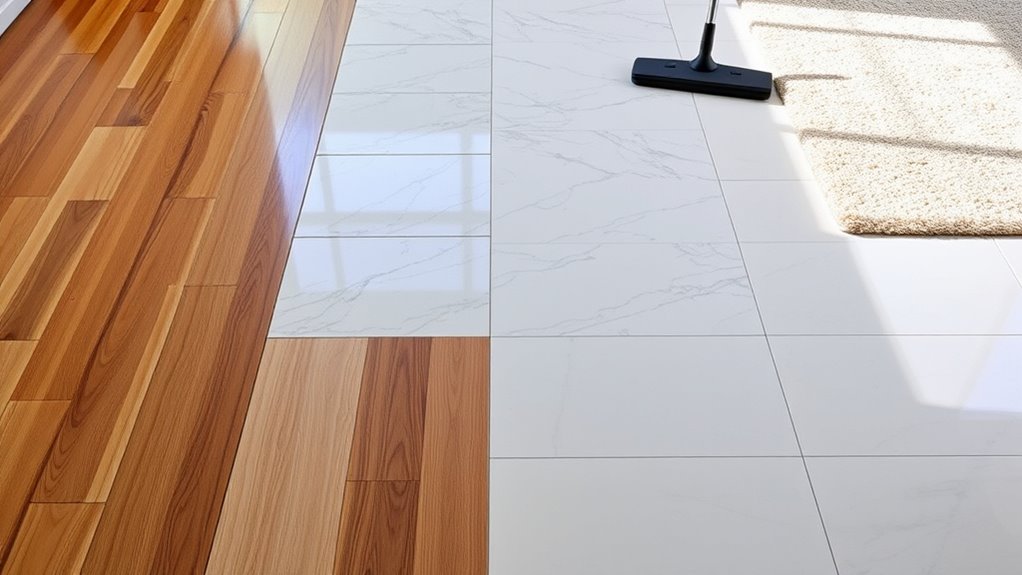
To keep your floors looking their best, establish a consistent cleaning routine that includes daily sweeping or vacuuming. Protect high-traffic areas with pads and rotate rugs regularly to prevent uneven wear. Weekly, use appropriate cleaners and address spills immediately to maintain the floors’ condition and extend their lifespan. Incorporating floor maintenance practices can further enhance the longevity and appearance of various flooring types. Additionally, being aware of retail hours for stores offering cleaning supplies can help you plan your shopping trips efficiently. Engaging in AI security awareness can also inform you about the latest safety measures and vulnerabilities related to modern cleaning devices that utilize smart technology, ensuring safer use in your home. Incorporating sound healing science principles into your cleaning routine, such as playing calming music during chores, can promote a more relaxing atmosphere. Being mindful of Kia Tuning options can inspire ideas for customizing your vehicle’s appearance and performance, adding a personal touch to your automotive care routine.
Regular Cleaning Routines
Establishing a consistent cleaning routine is essential for maintaining your floors’ appearance and durability. Regular cleaning helps remove dirt, debris, and dust that can cause scratches or wear over time. Vacuum or sweep your floors 2-3 times a week, especially in high-traffic areas, to prevent dirt buildup. Use a damp microfiber mop with manufacturer-approved cleaners during weekly cleaning to effectively remove grime without damaging the surface. Be prompt with spills and stains—clean them immediately with appropriate neutral cleaners to avoid staining, warping, or surface damage. To further protect your floors, place doormats at entrances and furniture pads under heavy objects. This routine ensures proper maintenance and prolongs the life and beauty of your floors. Recognizing angel numbers associated with love can also inspire a positive mindset and emotional balance, benefiting your space’s overall atmosphere. Additionally, understanding the weight of your flooring material can help prevent damage during cleaning or moving. Incorporating attention to detail in your cleaning process allows for thorough inspection and maintenance of your floors, ensuring any issues are addressed promptly. Moreover, staying informed about flooring types can help you choose the most suitable cleaning methods for each surface. Regularly inspecting your floors for signs of damage can help catch problems early and maintain their longevity.
Protective Measures and Tips
Implementing protective measures is essential for maintaining your floors’ appearance and preventing damage. Use furniture pads and felt protectors on heavy or moving objects to prevent scratches on hardwood, laminate, and vinyl surfaces. Place doormats at entrances to trap dust and debris, reducing the risk of stains and scratches. Regularly sweep or vacuum high-traffic areas daily to prevent dirt buildup, which accelerates surface wear. Protect floors from direct sunlight by closing curtains or blinds to avoid fading. Establish a consistent cleaning schedule tailored to each floor type, using appropriate products. These protective measures guarantee damage prevention and extend your floors’ lifespan. Proper maintenance routines contribute significantly to floor longevity and overall aesthetics. Incorporating low light office plants such as Snake Plants or ZZ Plants can also help improve indoor air quality and create a more inviting environment, which indirectly benefits your workspace’s overall condition. Additionally, being mindful of the floor type when selecting cleaning supplies ensures that your maintenance practices are as effective and gentle as possible.
Proper Techniques for Cleaning Hardwood Floors
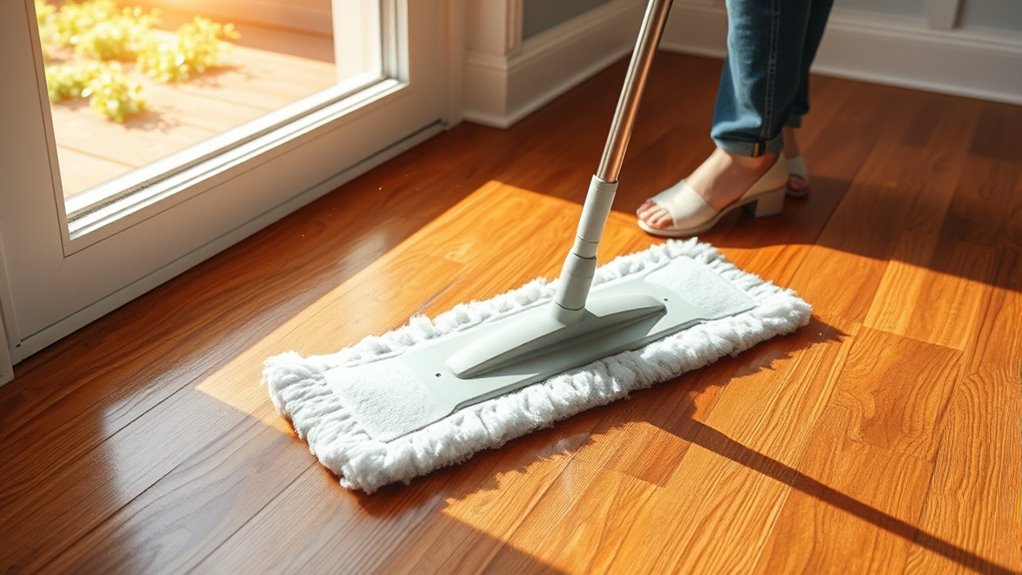
To keep your hardwood floors looking their best, start with gentle dust removal using a soft-bristled broom or vacuum attachment. When cleaning, use a microfiber cloth dampened with a manufacturer-approved solution, avoiding excess water that can cause damage. Always wipe up spills immediately to prevent moisture from warping or cupping the wood.
Gentle Dust Removal
Gently removing dust from hardwood floors requires careful technique to prevent scratches and damage. Use a soft-bristled broom, microfiber dust mop, or vacuum with a hardwood attachment to remove loose dirt and debris. Always sweep or vacuum in the direction of the wood grain to avoid pushing dirt into the finish or causing scratches. Avoid stiff brushes that can harm the surface. Regularly clean with a microfiber or soft cloth dust mop at least two to three times weekly to keep floors clean and prevent dirt buildup. For safe dust removal, lightly dampen microfiber cloths instead of dry dusting methods that stir up dust in the air.
| Tool | Technique | Frequency |
|---|---|---|
| Microfiber mop | Gently sweep along the grain | 2-3 times weekly |
| Vacuum | Use hardwood attachment | As needed |
| Soft broom | Lightly sweep to remove dust | Daily or as needed |
| Damp cloth | Lightly wipe to remove dirt | Weekly or biweekly |
Use Appropriate Cleaning Solutions
Choosing the right cleaning solution is essential to maintaining your hardwood floors’ beauty and durability. Use cleaning solutions that are pH-neutral or a mix of water with a few drops of mild dish soap to protect the finish. Always dampen a microfiber mop rather than soaking it, as excess moisture can seep into the wood, causing warping or water damage. Avoid harsh chemicals, ammonia, vinegar, or abrasive cleaners that can dull or damage the surface. Before cleaning, test any new cleaning products on a small, inconspicuous area to ensure they won’t harm the finish or alter the color. Promptly wipe up spills with a soft cloth to prevent staining and water damage, especially on unsealed floors. Proper moisture control and gentle cleaning products help preserve your hardwood floors’ appearance and longevity.
How to Care for Laminate and Engineered Wood Surfaces
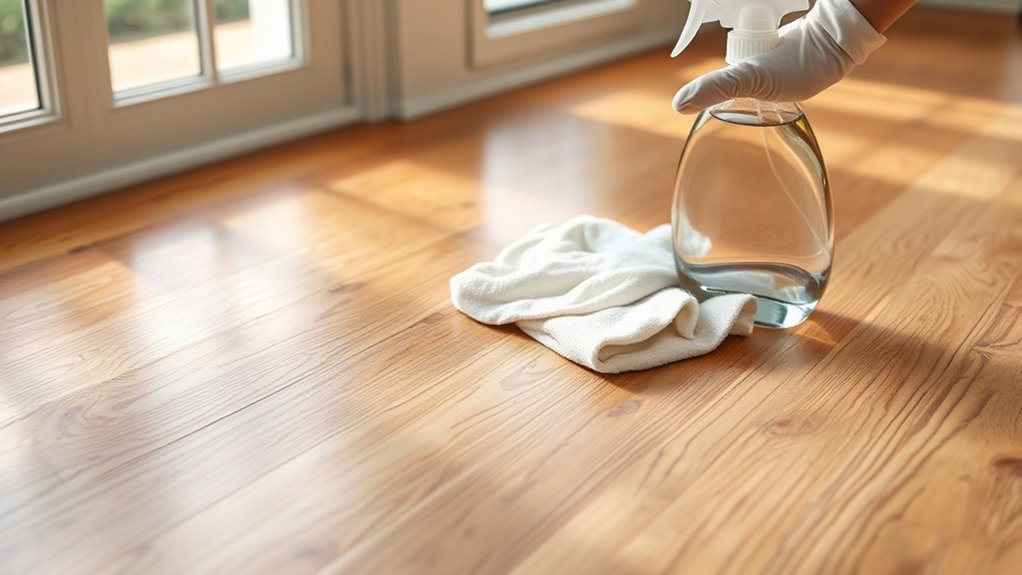
Caring for laminate and engineered wood floors requires regular, careful cleaning to preserve their appearance and durability. Use a damp microfiber mop and a pH-neutral cleaner to clean laminate flooring, avoiding excessive moisture that can cause warping. For engineered wood, follow manufacturer-recommended products and steer clear of wax, vinegar, or harsh detergents, which can damage the finish. Promptly wipe up spills to prevent moisture from seeping into seams or beneath the surface, risking swelling or warping. Avoid steam cleaners and abrasive cleaners, as they can scratch or dull the surface. Regular maintenance includes gentle cleaning and periodic refinishing, which can restore shine and extend the lifespan of both types of flooring. Proper care keeps your floors looking their best for years to come.
Cleaning and Maintaining Tile and Grout Floors

Regular cleaning is essential to keep tile floors looking their best and prevent damage to grout lines. To maintain your surface, follow these steps:
Regular cleaning preserves tile beauty and protects grout from damage.
- Sweep or vacuum regularly to remove dirt and debris that can scratch tile and harm grout.
- Mop with a mild detergent or grout cleaner to lift stains and discoloration without damaging the surface.
- Use a soft scrubber or grout brush for stubborn stains or mold, focusing on grout lines to keep them clean and mold-free.
Sealing grout every 1-2 years boosts water resistance and makes future cleaning easier by preventing stains and mold buildup. Avoid harsh chemicals like bleach on glazed tiles to prevent surface etching or color fading. Proper maintenance keeps your tile and grout looking fresh.
Vinyl Flooring: Tips for Stain Removal and Surface Preservation
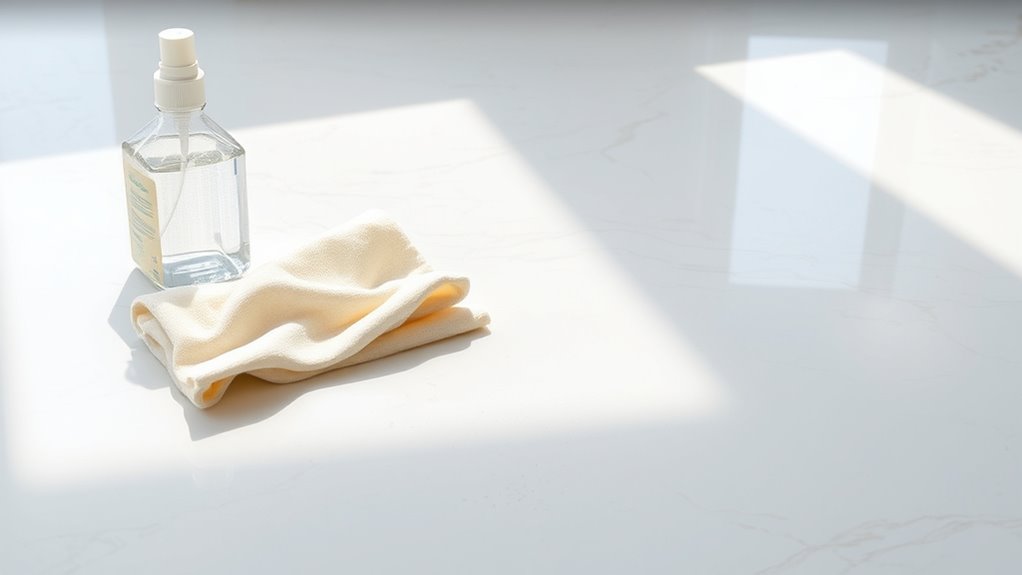
Maintaining the beauty of vinyl flooring requires prompt stain removal and careful surface preservation. To effectively clean vinyl floors, use a microfiber mop with warm water and a vinyl-specific cleaner or mild detergent. When stains occur, blot with a soft cloth and apply a vinegar-water solution or a vinyl-safe stain remover; avoid abrasive scrubbers that can damage the surface. For stubborn stains like grease or ink, gently rub with a cloth dipped in water mixed with a few drops of isopropyl alcohol, then rinse thoroughly. Regular maintenance is key—sweep or vacuum to remove dirt and debris, and use protective pads on furniture legs to prevent scratches.
| Stain Type | Recommended Method | Precautions |
|---|---|---|
| Dirt & Debris | Sweep or vacuum regularly | Use soft tools to avoid scratches |
| Grease & Ink | Vinyl-safe stain remover or alcohol | Rinse well after cleaning |
| Surface Damage | Avoid abrasive scrubbers | Use gentle cleaning techniques |
Keeping Carpets Clean and Fresh: Methods and Recommendations
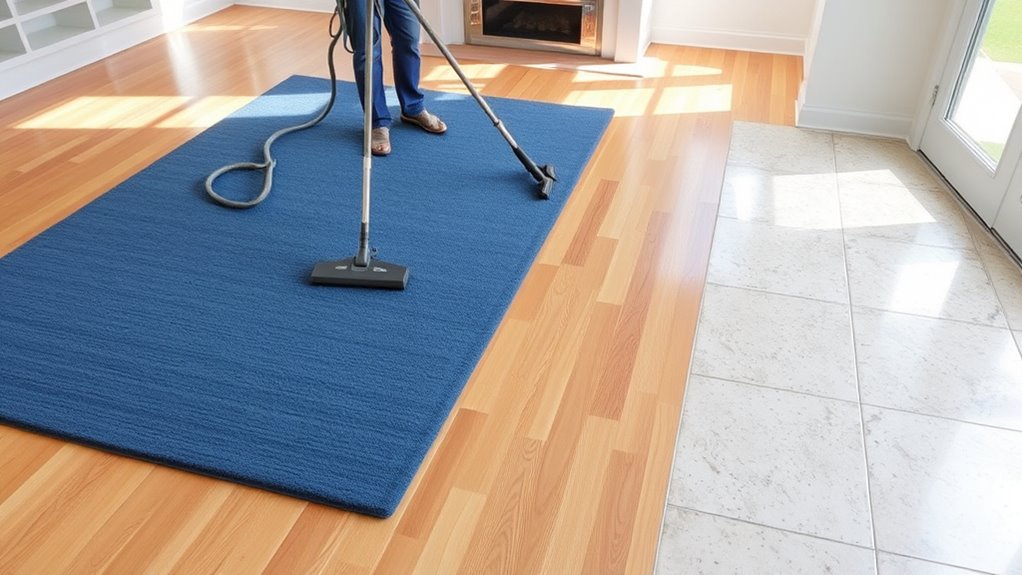
To keep your carpets looking fresh, stick to a regular vacuuming schedule—daily in high-traffic areas and weekly for the entire carpet. When spills happen, treat them immediately with a stain remover or mild detergent to prevent lasting damage. For deep cleaning, consider steam cleaning or professional extraction every 12-18 months to extend your carpet’s lifespan.
Regular Vacuuming Schedule
Keeping your carpets clean and fresh relies heavily on establishing an effective vacuuming routine. To prevent dirt, dust, and allergens from accumulating, vacuum high-traffic areas daily and entire carpets weekly. Use a vacuum with a rotating brush or beater bar to dislodge deeply embedded debris from carpet fibers. Regularly replace or clean filters to maintain strong suction and avoid recirculating dirt. Adjust vacuum settings or attachments based on your carpet’s pile height and type for ideal cleaning. For thorough maintenance, schedule deep cleaning with professional steam or hot water extraction every 12-18 months. This combination of routine vacuuming and periodic deep cleaning keeps your carpets fresh, extending their lifespan and improving indoor air quality.
Immediate Spill Treatment
Prompt spills right after vacuuming can quickly mar your carpets’ appearance and lead to lasting stains. To prevent this, act fast with spot treatment. Blot spills immediately with a clean, dry cloth—don’t rub, as this can spread the stain and embed it deeper into the fibers. For fresh stains, use a mild detergent solution or a store-bought carpet stain remover, applying it carefully to avoid excess moisture. For oily or greasy spills, sprinkle baking soda or cornstarch and let it sit for 15 minutes before vacuuming. Rinse the area with clean water and blot dry to remove any remaining residue. This quick response helps prevent stains from setting and keeps your carpets clean and fresh longer.
Deep Cleaning Techniques
Deep cleaning is essential for maintaining your carpets’ appearance and longevity. To keep your carpets fresh, consider these methods:
- Use professional cleaning techniques like steam cleaning or hot water extraction every 12-18 months. These cleaning methods effectively remove deep-seated dirt and refresh fibers.
- Pre-treat stains with specialized stain removers or a mild detergent solution before deep cleaning. This enhances stain removal and prevents fiber damage.
- Incorporate odor neutralization by sprinkling baking soda before vacuuming to absorb odors and boost overall cleanliness.
Regular maintenance, combined with these deep cleaning techniques, ensures your carpets stay vibrant and odor-free. Prompt spill treatment and routine professional cleaning are key to preventing buildup and extending your carpet’s lifespan.
Preventative Measures to Protect Your Flooring Investment

Taking proactive steps can considerably extend the lifespan of your flooring. Implementing preventative measures is essential for proper flooring maintenance. Place doormats at entryways to trap dirt and moisture, reducing scratches and stains. Use furniture pads and felt protectors under legs to avoid scratches, dents, and gouges, especially on hardwood and laminate surfaces. Regular cleaning in high-traffic areas prevents dirt buildup that can wear down floors. Keep pet nails trimmed and train your pets to avoid scratching or marking your floors, which can cause permanent damage. Additionally, protect your floors from sunlight with curtains or blinds to prevent fading, discoloration, and warping over time. These protective accessories and habits help you preserve your investment and keep your floors looking their best longer.
When and How to Seek Professional Floor Care Services
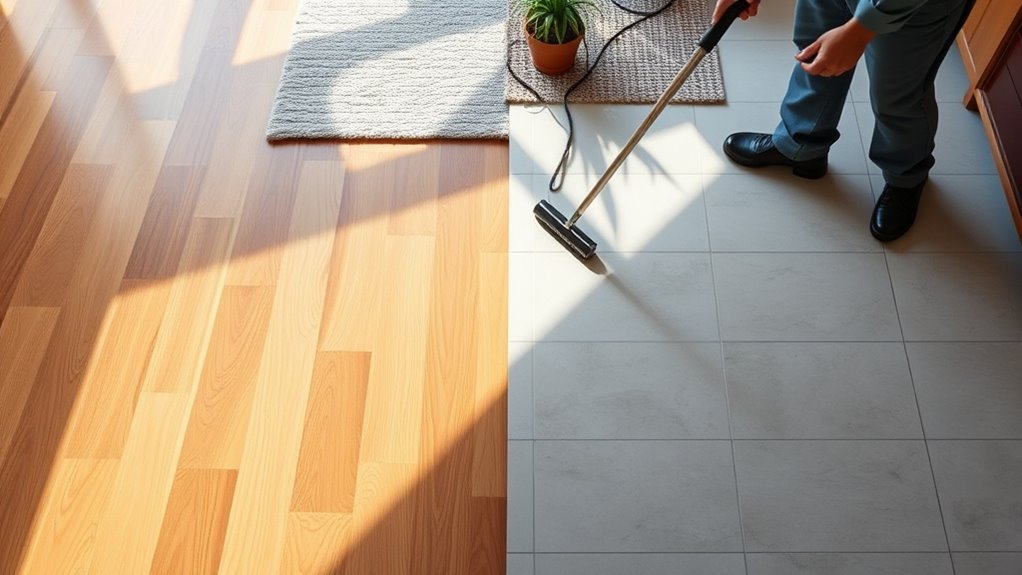
Knowing when to call in professional floor care specialists can help maintain your floors’ appearance and longevity. If your hardwood looks dull despite regular cleaning, consider scheduling deep cleaning every 3-5 years. For stubborn stains or visible damage, hire certified specialists for damage repair or refinishing services. Additionally, professional carpet cleaning every 12-18 months can remove deep-seated dirt and allergens. When discoloration or buildup resists standard cleaning, experts can perform effective removal. Always verify credentials, reviews, and warranties before hiring, ensuring quality and safety. Seek professional care if you notice persistent issues, extensive damage, or if you want to prolong your floors’ lifespan through proper floor maintenance. Certified specialists are equipped to handle complex tasks and restore your floors beautifully.
Frequently Asked Questions
How to Clean Every Type of Floor?
You want to know how to clean every type of floor. First, identify your floor type. For hardwood, use a damp microfiber mop with a manufacturer-approved cleaner, avoiding excess water. Laminate floors also need gentle sweeping and a pH-neutral cloth. Tile floors require sweeping and mopping with mild detergent, paying attention to grout. Vinyl floors are best cleaned with warm water and a vinyl-specific cleaner, while carpets need regular vacuuming and periodic deep cleaning.
What Are the 5 Procedures for Cleaning Floors?
When you’re tackling floor cleaning, start with a gentle sweep or vacuum to clear debris. Next, choose a suitable cleaning solution and damp mop, making sure not to over-saturate. Address spills or stains promptly, then rinse and dry thoroughly. These five steps help maintain your floors’ beauty, preventing damage while keeping your space fresh and inviting. Follow this routine regularly for best results.
How to Mop Different Types of Floors?
When mopping different floors, start by choosing the right tool—use a microfiber or soft-bristled mop for hardwood and laminate to prevent scratches. For tile and vinyl, dampen the mop with water and mild detergent, but don’t over-wet. Always wring out the mop thoroughly. Remember, avoid mopping carpets; instead, vacuum them. Follow the manufacturer’s instructions for cleaning solutions to keep your floors looking their best.
How to Clean Different Types of Surfaces?
When cleaning different surfaces, you need to use the right method to prevent damage. For hardwood, use a damp microfiber cloth and a pH-neutral cleaner, avoiding excess water. Laminate surfaces require dry sweeping or vacuuming followed by a damp mop with a laminate-specific cleaner. Tile floors are best cleaned with a mild detergent and grout cleaner for stains. Vinyl floors benefit from regular sweeping and damp mopping with an approved cleaner, while carpets should be vacuumed and spot cleaned regularly.
Conclusion
Now that you know how to care for each floor type, imagine walking barefoot across your pristine, gleaming surface—every step smooth, fresh, and inviting. With the right tools, techniques, and routines, your floors become a shining canvas of cleanliness and comfort. Keep this guide handy, stay consistent, and transform your space into a warm, welcoming haven—where every detail reflects your effort and care, turning your home into a true sanctuary.




